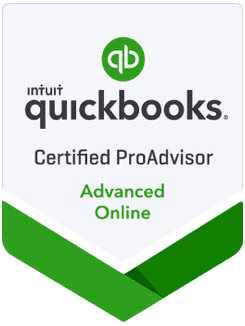Do you need to know how to take client deposits on work to be performed in QuickBooks® Online?
What are Client Deposits?
On big customer jobs, a company may take a preliminary or up-front payment, even though the work hasn’t started yet. That allows the business to hold time on their calendar, buy materials, or start the design process.
To create this workflow in QuickBooks Online, there are several approaches you can take:
- Take an initial first payment against the invoice using QBO’s Deposits feature.
- Make a Payment without creating an Invoice, then make the Invoice later.
- Create Deposits Liability category until the work is performed.
There are benefits and drawbacks to each method, depending on how you want the deposit or retainer to show up in your Accounts Receivable on your Balance Sheet.
So, how do you do this in QuickBooks® Online?
Well…it’s going to be easier to show you than to explain it. Each of the three options involves a one-time setup, and then has its own workflow. Please click here to watch Alicia’s free video demonstrating how to set up QBO to take a Deposit from your clients.
But in case you don’t like watching videos, here are the instructions…
QBO’s Built-in Deposits Feature
This works best when you’re ready to make the Invoice, and have already received the money.
The first step is to turn on the Deposits option in the Company Settings. Go to the Gear > Account and Settings.
Click on Sales on the left. Put a checkmark in front of Deposit.
Next, create a new Invoice, or open the existing invoice for the project.
In the Deposit field on the bottom right, enter the amount of money you received. When you do, a new set of boxes will appear on the left above the Product/Service grid. Enter the type of payment you received, and where you’re putting it (either Undeposited Funds or your bank account).
The Customer Deposit has now been counted as Income, and the balance remains on the Invoice for future payment.
Properly Managing Customer Deposits
This method of managing Customer Deposits on work to be performed enters the Deposit in QBO as a retainer, and not as the first payment.
Doing it this way temporarily holds the money on your Balance Sheet in a separate Deposits Received account. When the project is paid for, the retainer amount moves onto your Profit and Loss statement as Income.
One thing that’s helpful about this method is that you can always double-click on the Deposits Received account on your Balance Sheet report to see all the money you are holding for different Customers until you complete their jobs.
Setting Up
There are two steps involved to set up Deposits on work to be performed. These only need to be done the first time:
- Create the Liability Account in the Chart of Accounts
Go to Transactions > Chart of Accounts > New. Create this Other Current Liability account:
- Create the Deposit Received item in the Products & Services List.
Go to Gear > Products and Services > New. Create this new Service item. Note that you can modify the wording to suit your needs.
By making the Income account a new Liability Account, when you use this Service, the money will go to this item on your Balance Sheet.
Receiving the Deposit
Now you’re ready to take your Retainer Deposit on Work to Be Performed!
- Record the Deposit.
If you have already received the money, go to +New > Sales Receipt. If you are billing the Client for this Deposit, go to +New > Invoice.
In the Product/Service field, choose your new Deposit Received item. Enter the amount of the Deposit.
When you now look at the Balance Sheet, you will see the ,being held on behalf of the Client. Click on the dollar amount to see all the Deposits you’re holding on all open jobs.
- Deduct the Prepayment from The Project’s Balance.
When it’s time to bill the Customer for the entire job (or a phase of it), add the same Deposit Received item at the bottom, but this time subtract the dollar amount to show the remaining balance to be paid.
When you revisit the Balance Sheet, the money is reallocated to the actual Income accounts used by the other line items on the Invoice.
Prepayments with No Invoice
Some people take a Payment without having an Invoice to apply it to. What is useful about this method is that you can see a negative balance when you run Accounts Receivable reports.
The limitation is that you have no tracking of Products and Services sold, you can’t track Sales Tax, and the money only shows up in Unapplied Cash Payment Income on cash-based Profit & Loss Statements.
What’s next?
This explanation of Client Deposits is just one excerpt of several creative uses of QBO that Alicia covers in her Bookkeeping’s Tricky Situations course. If you learned something from this article, you’ll love her other techniques for bartering, managing bounced checks, managing loans, negative deposits, and more. Please click here to register!
This explanation is also a chapter in Alicia’s QBO Book on Amazon.com (with pictures!).





0 Comments